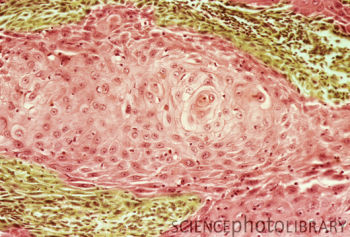
口腔鳞状细胞癌光镜照相(图)
口腔鳞状细胞癌发病率在所有颈部和头部癌症患者总人数中大约占有1/4的比例。它是癌症引起死亡的主要因素—主要是由于目前没有有效的组织检查方法预测癌症是否会复发。
在最新一期的《BMC Cancer》杂志上,科学家们发现有四种基因的表达可以准确的预测患者复发口腔鳞状细胞癌的风险。
来自加拿大安大略湖癌症中心的,由Suzanne Kamel-Reid博士和Igor Jurisica博士负责的研究小组收集了多伦多综合医院的多例口腔鳞状细胞癌和非口腔鳞状细胞癌患者的口腔组织样本,并进行了检测。
研究者们使用了meta分析的统计方法,综合了之前研究报道的五项基因芯片研究结果,并结合自己的研究结果,准确的找除了在口腔鳞状细胞癌组织中高表达的138种基因。并发现其中有四种基因与口腔鳞状细胞癌的复发率密切相关,它们分别是MMP1, COL4A1, P4HA2和THBS2。
研究者们说道:“我们的数据显示高表达MMP1, COL4A1, P4HA2和THBS2与高的口腔鳞状细胞癌复发率相关。这项研究将有助于未来临床口腔鳞状细胞癌的复发诊断。” (生物探索 Jun)
相关英文论文摘要:
A gene signature in histologically normal surgical margins is predictive of oral carcinoma recurrence
Samples were prospectively collected from patients with histologically normal surgical resection margins. 96 tissue samples (histologically normal margins, oral carcinoma and adjacent normal tissues) from 24 patients comprised the training set. Our study design was guided by the hypothesis that the expression of genes present in oral squamous cell carcinoma (OSCC) but not in healthy oral tissues would be indicative of recurrence in advance of histological alteration. We used meta-analysis of five published microarray data sets (GEO accession GDS2520, Kuriakose et al. 2004; GDS1584, Toruner et al. 2004; GSE6791, Pyeon et al. 2007; GSE9844, Ye et al. 2008; and GSE10121, Sticht et al. 2008), in conjunction with the current training set, to identify genes reliably over-expressed in OSCC. This reduced gene set was used to train a risk model to predict recurrence based on over-expression of a subset of these genes in histologically normal surgical resection margins. Validation of the risk signature was performed using quantitative real-time reverse-transcription PCR in an independent set of 136 samples from an independent cohort of 30 patients.







